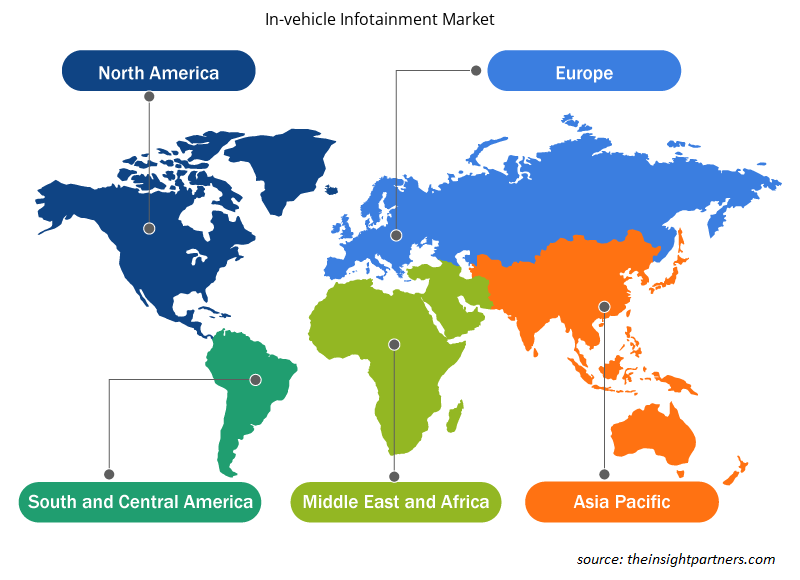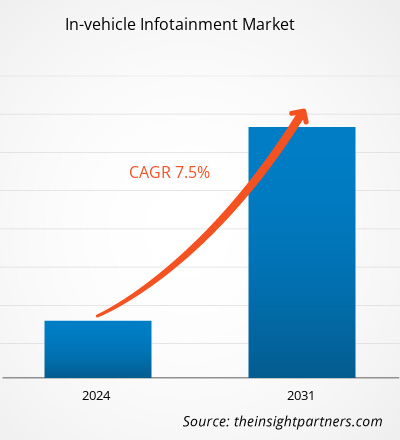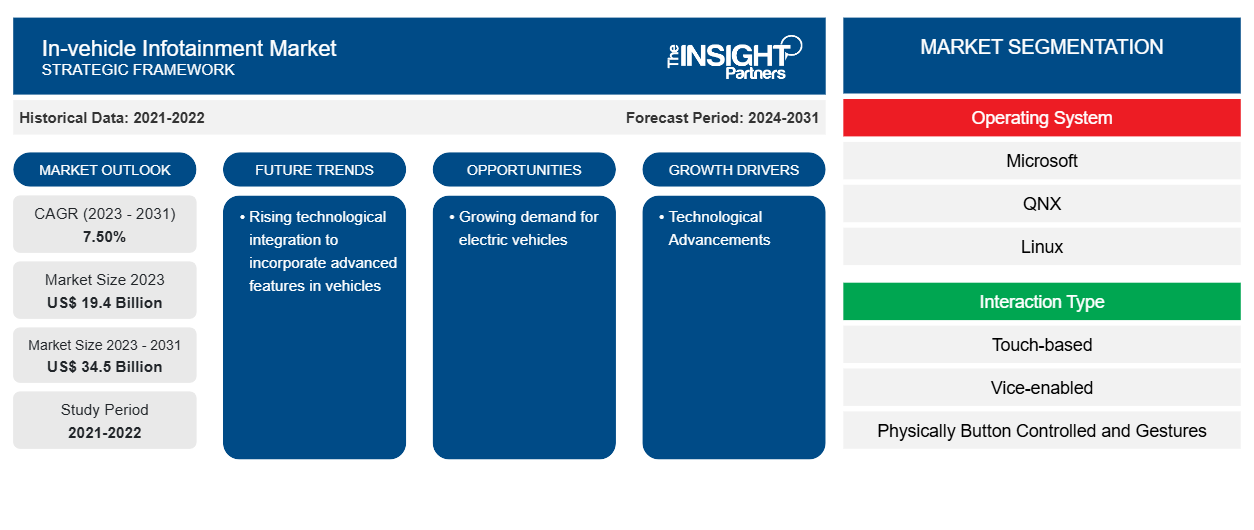Der Markt für Infotainmentsysteme im Fahrzeug soll von 19,4 Milliarden US-Dollar im Jahr 2023 auf 34,5 Milliarden US-Dollar im Jahr 2031 anwachsen. Der Markt soll zwischen 2023 und 2031 eine durchschnittliche jährliche Wachstumsrate (CAGR) von 7,50 % verzeichnen. Die Integration von Fahrerassistenzsystemen (Advanced Drivers Assistance System, ADAS) in Infotainmentsysteme ist einer der jüngsten Trends in der Branche. ADAS-Funktionen wie Spurhalteassistenten, Einparkhilfen und adaptive Geschwindigkeitsregelung sind einige der jüngsten Trends in der Branche, die lukrative Möglichkeiten schaffen.
Marktanalyse für Infotainmentsysteme im Fahrzeug
Die gesteigerte Produktion und der Verkauf von Personenkraftwagen sind einer der bemerkenswerten Faktoren, die das Wachstum des Marktes für Infotainmentsysteme in Fahrzeugen vorantreiben. Aufgrund der zunehmenden Urbanisierung und des gestiegenen verfügbaren Einkommens sind die Verkäufe von Personenkraftwagen in den letzten Jahren weltweit gestiegen. Laut den von der Organisation Internationale des Constructeurs d'Automobiles im Jahr 2023 veröffentlichten Daten erreichte die Produktion von Personenkraftwagen weltweit im Jahr 2022 58 Millionen Einheiten, im Jahr 2023 erreichte die Produktion jedoch 65 Millionen Einheiten. Diese gesteigerte Fahrzeugproduktion und -verkäufe pro Jahr treiben die Nachfrage auf dem Markt für Infotainmentsysteme in Fahrzeugen an.
Marktübersicht für Infotainmentsysteme im Fahrzeug
Die Nachfrage nach Infotainmentsystemen für Fahrzeuge im asiatisch-pazifischen Raum ist in den letzten Jahren ebenso gestiegen wie die Nachfrage nach Personenkraftwagen. Die Nachfrage wird hauptsächlich durch das gestiegene verfügbare Einkommen im asiatisch-pazifischen Raum getrieben. Laut den Daten der Organisation Internationale des Constructeurs d'Automobiles aus dem Jahr 2023 betrug die Produktion von Personenkraftwagen in der Region im Jahr 2021 18 Millionen, im Jahr 2022 erreichte die Produktion von Personenkraftwagen jedoch 24 Millionen. Durch diesen Anstieg des Fahrzeugabsatzvolumens stieg die Nachfrage nach Infotainmentsystemen für Fahrzeuge im asiatisch-pazifischen Raum.
Passen Sie diesen Bericht Ihren Anforderungen an
Sie erhalten kostenlos individuelle Anpassungen an jedem Bericht, einschließlich Teilen dieses Berichts oder einer Analyse auf Länderebene, eines Excel-Datenpakets sowie tolle Angebote und Rabatte für Start-ups und Universitäten.
-
Holen Sie sich die wichtigsten Markttrends aus diesem Bericht.Dieses KOSTENLOSE Beispiel umfasst eine Datenanalyse von Markttrends bis hin zu Schätzungen und Prognosen.
Treiber und Chancen für den Infotainmentmarkt im Fahrzeug
Technologischer Fortschritt
Einer der bemerkenswerten Faktoren hinter dem Wachstum des Marktes ist der technologische Fortschritt bei Smartphone- und Cloud-Technologie. Mit der zunehmenden Verbreitung von Smartphones begannen viele Hersteller von Fahrzeug-Infotainmentsystemen, Systeme anzubieten, die über eine Smartphone- Konnektivität verfügen. Darüber hinaus begannen Unternehmen, als das Konzept der Cloud-Technologie in der Fahrzeug-Infotainmentsoftware aufkam, Cloud-Technologie zu verwenden, um maßgeschneiderte Funktionen und Dienste bereitzustellen. Aufgrund der technologischen Entwicklung im Fahrzeug-Infotainment stieg die Nachfrage nach Fahrzeug-Infotainment weltweit.
Integration künstlicher Intelligenz
Da die Nachfrage nach autonomen Fahrzeugen rasant steigt, entwickeln sich gleichzeitig auch die Infotainmentsysteme in Fahrzeugen weiter. Darüber hinaus steigt auch die Anzahl der Bildschirme in Personenkraftwagen, da die Nachfrage nach Unterhaltung und Autonomie zunimmt. Daher konzentrieren sich viele Akteure der Automobilindustrie darauf, künstliche Intelligenz als Assistent des Fahrers in ihre Autos zu integrieren.
Segmentierungsanalyse des Marktberichts für Infotainment im Fahrzeug
Wichtige Segmente, die zur Ableitung der Marktanalyse für Infotainment im Fahrzeug beigetragen haben, sind Betriebssystem, Interaktionstyp und Konnektivitätstechnologie.
- Basierend auf dem Betriebssystem ist der Markt für Infotainmentsysteme im Fahrzeug in Microsoft, QNX und Linux unterteilt.QNX, Linux.
- Nach Interaktionstyp ist der Markt in berührungsbasierte, schaltergesteuerte, physisch tastengesteuerte und Gestensteuerung unterteilt. Das berührungsbasierte Segment hatte im Jahr 2023 den größten Marktanteil.
- In Bezug auf die Kategorien ist der Markt in Wi-Fi, Bluetooth und NFC unterteilt. Das Bluetooth-Segment dominierte den Markt im Jahr 2023.
Marktanteilsanalyse für Infotainmentsysteme im Fahrzeug nach geografischen Gesichtspunkten
Der geografische Umfang des Berichts zum Markt für Infotainmentsysteme in Fahrzeugen ist hauptsächlich in fünf Regionen unterteilt: Nordamerika, Asien-Pazifik, Europa, Naher Osten und Afrika sowie Südamerika/Süd- und Mittelamerika.
Der globale Markt für Infotainmentsysteme für Fahrzeuge wird vom asiatisch-pazifischen Raum dominiert; Nordamerika und Europa sind jedoch auch wichtige Regionen der Branche. Im asiatisch-pazifischen Raum hat sich China zum Produktionszentrum der globalen Automobilindustrie entwickelt. Laut öffentlich zugänglichen Daten stiegen die Autoverkäufe in China im Jahr 2023 im Vergleich zu 2022 um 12 %. Darüber hinaus meldete China laut jüngsten Statistiken im Jahr 2023 Exporte von mehr als 5 Millionen. Aufgrund der starken Automobilindustrie im asiatisch-pazifischen Raum stieg die Nachfrage nach Infotainmentsystemen für Fahrzeuge.
Regionale Einblicke in den Markt für Infotainment im Fahrzeug
Die regionalen Trends und Faktoren, die den Markt für Infotainmentsysteme im Fahrzeug während des Prognosezeitraums beeinflussen, wurden von den Analysten von Insight Partners ausführlich erläutert. In diesem Abschnitt werden auch Marktsegmente und Geografien für Infotainmentsysteme im Fahrzeug in Nordamerika, Europa, im asiatisch-pazifischen Raum, im Nahen Osten und Afrika sowie in Süd- und Mittelamerika erörtert.

- Erhalten Sie regionale Daten zum Markt für Infotainmentsysteme im Fahrzeug
Umfang des Marktberichts zum Infotainment im Fahrzeug
| Berichtsattribut | Details |
|---|---|
| Marktgröße im Jahr 2023 | 19,4 Milliarden US-Dollar |
| Marktgröße bis 2031 | 34,5 Milliarden US-Dollar |
| Globale CAGR (2023 - 2031)CAGR (2023 - 2031) | 7,50 % |
| Historische Daten | 2021-2022 |
| Prognosezeitraum | 2024–2031 |
| Abgedeckte Segmente |
Nach Betriebssystem
|
| Abgedeckte Regionen und Länder |
Nordamerika
|
| Marktführer und wichtige Unternehmensprofile |
|
Marktteilnehmerdichte: Der Einfluss auf die Geschäftsdynamik
Der Markt für Infotainmentsysteme in Fahrzeugen wächst rasant. Dies wird durch die steigende Nachfrage der Endnutzer aufgrund von Faktoren wie sich entwickelnden Verbraucherpräferenzen, technologischen Fortschritten und einem größeren Bewusstsein für die Vorteile des Produkts vorangetrieben. Mit der steigenden Nachfrage erweitern Unternehmen ihr Angebot, entwickeln Innovationen, um die Bedürfnisse der Verbraucher zu erfüllen, und nutzen neue Trends, was das Marktwachstum weiter ankurbelt.
Die Marktteilnehmerdichte bezieht sich auf die Verteilung der Firmen oder Unternehmen, die in einem bestimmten Markt oder einer bestimmten Branche tätig sind. Sie gibt an, wie viele Wettbewerber (Marktteilnehmer) in einem bestimmten Marktraum im Verhältnis zu seiner Größe oder seinem gesamten Marktwert präsent sind.
Die wichtigsten Unternehmen auf dem Markt für Infotainmentsysteme im Fahrzeug sind:
- Alpine Electronics, Inc.
- Clarion Co., Ltd.
- Continental AG
- Denso Ten Limited
- Garmin Ltd.
- Harman International
Haftungsausschluss : Die oben aufgeführten Unternehmen sind nicht in einer bestimmten Reihenfolge aufgeführt.

- Erhalten Sie einen Überblick über die wichtigsten Akteure auf dem Markt für Infotainmentsysteme im Fahrzeug
Nachrichten und aktuelle Entwicklungen zum Markt für Infotainmentsysteme im Fahrzeug
Der Markt für Infotainmentsysteme im Fahrzeug wird durch die Erhebung qualitativer und quantitativer Daten nach Primär- und Sekundärforschung bewertet, die wichtige Unternehmensveröffentlichungen, Verbandsdaten und Datenbanken umfasst. Im Folgenden finden Sie eine Liste der Entwicklungen auf dem Markt für Infotainmentsysteme im Fahrzeug und der Strategien:
- Snapp Automotive hat ein Android-Infotainmentsystem für Autos auf den Markt gebracht. SnappOS ist ein anpassbares, kontextbezogenes und intelligentes Infotainmentsystem, das schnelle Entwicklungszyklen und den Einsatz in realen oder simulierten Umgebungen ermöglicht. (Quelle: Snapp Automotive, Pressemitteilung/Unternehmenswebsite/Newsletter, 2022)
- Panasonic Automotive System hat ein Update für sein In-Vehicle-Infotainmentsystem (IVI) SkipGen angekündigt, das Zugriff auf Siri oder Alexa bietet. (Quelle: Panasonic Automotive System, Pressemitteilung/Unternehmenswebsite/Newsletter, 2023)
Marktbericht zum Infotainment im Fahrzeug – Abdeckung und Ergebnisse
Der Bericht „Marktgröße und Prognose für Infotainmentsysteme im Fahrzeug (2021–2031)“ bietet eine detaillierte Analyse des Marktes, die die folgenden Bereiche abdeckt:
- Marktgröße und Prognose auf globaler, regionaler und Länderebene für alle wichtigen Marktsegmente, die im Rahmen des Projekts abgedeckt sind
- Marktdynamik wie Treiber, Beschränkungen und wichtige Chancen
- Wichtige Zukunftstrends
- Detaillierte PEST/Porters Five Forces- und SWOT-Analyse
- Globale und regionale Marktanalyse mit wichtigen Markttrends, wichtigen Akteuren, Vorschriften und aktuellen Marktentwicklungen
- Branchenlandschaft und Wettbewerbsanalyse, einschließlich Marktkonzentration, Heatmap-Analyse, prominenten Akteuren und aktuellen Entwicklungen
- Detaillierte Firmenprofile
- Historische Analyse (2 Jahre), Basisjahr, Prognose (7 Jahre) mit CAGR
- PEST- und SWOT-Analyse
- Marktgröße Wert/Volumen – Global, Regional, Land
- Branchen- und Wettbewerbslandschaft
- Excel-Datensatz
Aktuelle Berichte
Verwandte Berichte
Erfahrungsberichte
Grund zum Kauf
- Fundierte Entscheidungsfindung
- Marktdynamik verstehen
- Wettbewerbsanalyse
- Kundeneinblicke
- Marktprognosen
- Risikominimierung
- Strategische Planung
- Investitionsbegründung
- Identifizierung neuer Märkte
- Verbesserung von Marketingstrategien
- Steigerung der Betriebseffizienz
- Anpassung an regulatorische Trends























 Kostenlose Probe anfordern für - Markt für Infotainment im Fahrzeug
Kostenlose Probe anfordern für - Markt für Infotainment im Fahrzeug